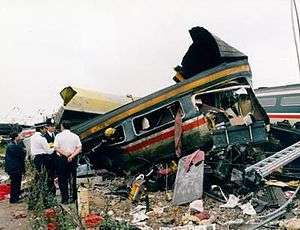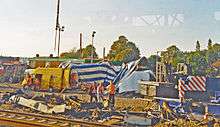Southall rail crash
The Southall rail crash occurred on 19 September 1997, on the Great Western Main Line at Southall, west London. An InterCity 125 passenger train failed to slow down in response to warning signals and collided with a freight train crossing its path, causing seven deaths and 139 injuries.
| Southall rail crash | |
|---|---|
 The remains of Coach G of the High Speed Train | |
| Details | |
| Date | 19 September 1997 13:20 |
| Location | Southall |
| Country | England |
| Line | Great Western Main Line |
| Operator | Great Western Trains (InterCity 125), Hanson (freight train) |
| Cause | Signal passed at danger |
| Statistics | |
| Trains | 2 |
| Passengers | 212 |
| Deaths | 7 |
| Injured | 139 |
| List of rail accidents in the United Kingdom | |
The signaller was unaware that the automatic warning system, which warns drivers of adverse signals, had been turned off in the cab of the express, and had set a route which would stop the express and allow the freight train to cross in front of it. If he had known, he would have been prevented from setting a conflicting route under the operating rules. The passenger train operating company had contravened the rules in failing to inform Railtrack and the signaller that the safety system was inoperative.[1] The HST driver, Larry Harrison, did not apply the brakes until it was too late because he was packing his bag and did not see the cautionary signals. He was charged with manslaughter by gross negligence but the case collapsed.
Great Western Trains, whose managing director survived the crash in one of the most badly affected carriages, was fined for failure to ensure High Speed Trains had their automatic warning system working during long journeys.
Accident
The collision occurred as the 10:32 Great Western Trains (GWT) InterCity 125 high speed passenger train (HST) returned from Swansea toward London Paddington. The train was formed of power car 43173, eight Mark 3 carriages and power car 43163 and the driver boarded the train at Cardiff. The first driver found that a fault with the Automatic Warning System (AWS) prevented the brakes from releasing (a recurrence of the previous day but the whole system had not malfunctioned since December 1996) so he isolated (disabled) it at 06:00, which was not reported to the signaller and to Railtrack — required by the Rulebook to enable extra signalling precaution.[1] The train driver passed two warning signals (a double yellow followed by a single yellow) without slowing the train down, and only reacted by applying the emergency brake when the red danger signal came into view.[2]
As the tracks straightened ahead of the HST, the driver saw the Hanson Class 59 locomotive 59101 a mile in the distance, moving "at a funny angle" and realised that it was crossing his path (the Up Main line). The freight train, which was formed of 20 empty bogie hopper wagons, was coming from London on the Down Relief line toward the north side, and had been signalled to cross the main lines at Southall East Junction on its way into Southall Yard on the south side. A collision was now inevitable. The HST was travelling at 125 miles per hour (201 km/h) when the driver saw the danger signal, so even though he applied the emergency brake the collision occurred at more than 80 miles per hour (130 km/h).[1][2]
Alan Bricker, the driver of the freight locomotive, observed the approaching HST and expected it to stop, but was alarmed by its speed and apparent brake application. He was praised for trying to accelerate his train out of its path of the HST. The later accident report found that:
- At 13:20, the front power car of the HST collided with a 22-tonne (22-ton) hopper car.[3]
- Two seconds later, coach H collided with a hopper. The HST power car severed the brake pipes of the freight train, causing the stranded rear hopper wagons to stop immediately. A coupling from one of the hoppers was then severed by the derailed and damaged front power car as it passed by, causing debris to land on the track.
- Four seconds into the accident, with the HST still travelling at 60 miles per hour (97 km/h), coach H collided with the severed coupling from the freight train, and began to topple away from the freight train onto its left side. It slid on its side for a further four seconds. Two people died in this carriage, falling from the destroyed coach windows and then crushed under the sliding Coach H.
- Eight seconds into the accident, with both the forward HST power car and coach H clear forward of the scene, coach G—the second coach in the HST formation—hit the now stationary rear of the freight train. The freight wagons were driven back and jackknifed.
- Both coach G and the struck hopper wagon lifted into the air. The hopper wagon was restrained in its movement, and collided and jammed up against the nearby overhead line stanchions. The front of coach G was flattened as it slid under the hopper.
- Ten seconds into the accident, the rear of the HST train led by coach F, collided with the now stationary coach G. The energy release of the still moving rear of the HST bent the structure of coach G into a distinct half-curve at its midpoint. Five people died in coach G, which was almost completely destroyed.
- The rear of the HST, led by coach F, collided with the stationary rear of the freight train. Coach F was left derailed.
Seven passengers died; six at the scene and one in hospital.[1]
The driver said he was aware of the isolated AWS and refers to putting items in his bag before the incident twice in his tape-recorded conversation with signallers at the nearest trackside telephone:
"I'm okay, yeah, I was just putting me stuff away in the bag the A, the A, the, the AWS has been isolated because some, some brake problem, I believe, so, I had no AWS so, I put me stuff away in the bag and the next thing I knew, I was coming up against red, up, such coming through, through...Through Southall, yeah"... ..."I was just putting me stuff away in the bag, like I would normally do, you see. (signaller: Right.) And all of a sudden I was whizzing through Hayes with a red at Southall (signaller: Right.) I see the slow train crossing over then"[1]:Annex 08
He did not see the preceding signals; functioning AWS would have given him an audible warning that he was running towards a signal at danger and needed to start braking.[1] Failure to press the AWS cancelling button to acknowledge the warning would have caused the emergency brake to apply. Automatic Train Protection (ATP) equipment would have almost certainly prevented the accident. The train was fitted with ATP but this was switched off. The equipment, both at trackside and in the London-end power car was fully operational, but was not switched on because neither drivers Harrison nor Tunnock were then qualified to drive with ATP.
The AWS had been reinstated at the depot overnight without the mandated electrical tests on it being carried out.[1]:Paragraph 6.26 If the AWS or the ATP equipment on the HST had been working, the chance of the accident occurring would have been highly unlikely. Since 1996 such trains have had their minimum number of drivers cut to one per journey and the driver admitted a lack of focus.[1]
Aftermath
Following this accident and the Ladbroke Grove rail crash, First Great Western (as GWT had become) required all its trains to have ATP switched on. If the equipment is faulty the train is taken out of service. It emerged after the incident that the reset switch of the warning system had contamination on its electrical contact surfaces which rendered its performance intermittent, hence its disabling at Oxford the day before the crash.[1]
The HST driver, Larry Harrison, was charged with manslaughter by gross negligence but the case collapsed.[4] GWT was fined £1.5 million for not having a system to ensure HSTs were not operated for long journeys with AWS inoperative.[5]

The action of the signaller in stopping a high-speed passenger train to allow a slow freight train to cross in front of it has been criticised. However, this is standard procedure when regulating trains to minimise overall delay; there was no reason for the signaller to expect that the HST driver would not stop at the red signal protecting the crossover. At the time there was no requirement for the signaller to have been informed that the HST was in service with its AWS isolated. The rulebook was altered to cover this;[6]
"Driver.....if you become aware that the AWS has become defective when it is required to be in operation, you must.....tell the signaller"
The key point identified in the report was that drivers had become increasingly reliant on AWS with single-manning and high speeds, and that it was no longer acceptable to run trains at full speed if the equipment was inoperative. The rulebook was changed,[6] so that if AWS is isolated the train may only run at high speed with a competent person accompanying the driver in the cab. This person must have full knowledge of the route and know how to stop the train;
"If a competent person is provided....proceed at normal permissible speed to the location where the train can be dealt with. During poor visibility, the train speed must not exceed 40 mph (65 km/h)"
or
"If a competent person is not provided...proceed at a speed not exceeding 40 mph (65 km/h), or any lower permissible speed that may apply, to the location where a competent person is available or to the location where the train can be dealt with"
Among survivors in the two most severely stricken coaches in front of the buffet car were Richard George, then managing director of GWT, who played a valuable role in establishing calm, and four injured members of staff in the buffet car, who quickly organised help for passengers.[1] After the completion of the inquiry, power car 43173 was scrapped at a remote site, MoD Shoeburyness.
References
- Professor John Uff QC FREn. "The Southall Rail Accident Inquiry Report" (PDF). HSE Books. Retrieved 7 November 2011.
- "Seven die as HST ploughs into stone empties'" Rail Magazine |issue 315 8 October 1997| pages 6–11
- TheRoute19 (27 August 2010). "Southall Train Crash 1997". Retrieved 12 December 2016 – via YouTube.
- Rail crash manslaughter charges dropped BBC News 2 July 1999
- Record fine after Southall crash BBC News 27 July 1999
- "Online Rulebook - Module: TW5 Defective or isolated vehicles and on-train equipment - Section 4.5 (If the AWS is defective or isolated)" (PDF). RSSB. Retrieved 10 June 2016.
- Hall, Stanley (1999). Hidden Dangers. Ian Allan. ISBN 0-7137-1973-7.
- Vaughan, Adrian (2000). Tracks to Disaster. Ian Allan. ISBN 978-0-7110-2731-2.
External links
- Reconstruction of the full incident from the 2003 BBC Documentary Collision Course, using computer generated graphics and CCTV footage from an adjoining yard.
- Footage of the accident site and efforts to clear the line.
- Health and Safety Commission report by Professor John Uff published 24 February 2000. 14 MB pdf file.
- Report by the Health and Safety Executive on progress made on the recommendations of the original report (February 2002). 333 kB pdf file.
- Danger Ahead! Southall 1997